6 Reasons Grim Fandango Still Holds Up As One of the Greatest Games Ever
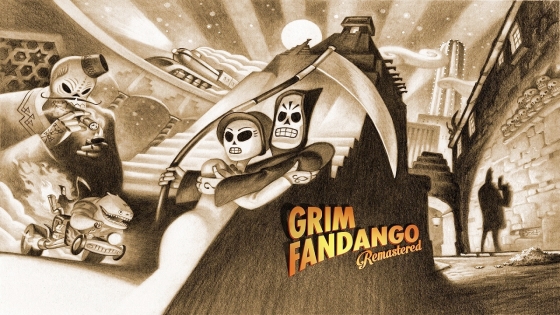 |
I’m just going to get this right out of the way: Grim Fandango is, in my opinion, one of the five greatest video games ever created (Mega Man 3 still holds my number-one position as the greatest, though). When I was in Junior High, it blew me away when I played it for the first time. I was really into graphic adventure games back then (still am), and expected something amazing, but I didn’t expect it to linger with me for long and leave such an impression on me, but it happened.
And now, here it is. After over a decade of popular demand, Grim Fandango is finally getting a re-release with Grim Fandango Remastered, a new edition of the game with a bunch of improvements and bonuses. God, was I excited for this. But not having played the game in over a decade, I was actually wondering…would Grim Fandango still hold up years later, or was I just wearing rose-colored glasses?
…Eh, well, I guess the title kind of gives away the answer to that question. Damn, gotta work on my intros…
First, a bit of information for those who don’t know much about the game. Grim Fandango is a graphic adventure game that involves the story of Manny Calavera, a reaper/travel agent for the Department of Death in the Mexican lore-inspired Land of the Dead, tasked with reaping souls and selling them high-quality travel packages to make their four-year journey of the soul to the Ninth Underworld as smooth as possible. Unfortunately, Manny’s current clients have been of rather low quality, leading to a massive sales slump for him. When his boss tells him he needs a premium sale by the end of the day or he’s fired, Manny takes things into his own hands and grabs his rival’s commission, a saintly soul known as Mercedes “Meche” Colomar. Mysteriously, though, Manny finds that the lovely lady doesn’t qualify for any notable packages despite being wholly deserving of one, and after Meche leaves out of embarrassment and Manny gets in hot water, he and his new friend/driver Glottis set out on a journey to find her.
The whole story goes much deeper than that, of course, and the end result was the core of a terrific game that garnered huge critical acclaim, several awards (including at least one Game of the Year award), and is still fondly remembered as a true classic that lands on countless “Best Game Ever” lists…so of course the game was a massive flop when it came to sales (overshadowed by this “Half-Life” game or whatever), becoming the only LucasArts game to not turn a profit and leading the company to abandon their classic adventure games, basically pumping out nothing but Star Wars games from then on.
Yes, it was the high point of adventure games and the death of adventure games. Go figure. So alas, cult status was the only way to go. So how does this cult classic stack up today? Well…
6. It Controls Even Better Now
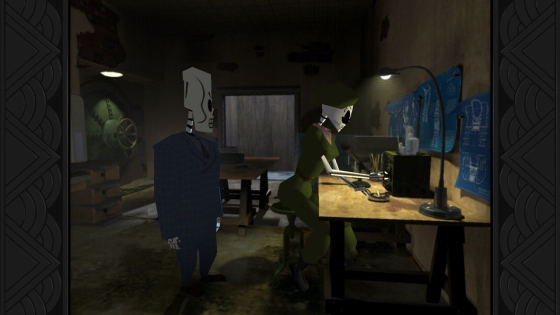 |
Let’s begin by addressing one of Grim Fandango’s few flaws it was criticized for when it first came out: The controls. Grim Fandango was one of the first graphic adventure games to use tank controls as a way of moving the character around, meaning you couldn’t move and turn at the same time. To be honest, I never once had a problem with these controls in the game when it came out, as far as I can remember. I got used to them fairly easily, and never understood what any of the complaints were about, thus leading me to imagine a bunch of computer gamers/graphic adventure fans fumbling about on their keyboards like a character in an infomercial while I snickered at them.
But Grim Fandango Remastered has now been upgraded to include camera-relative dual-joystick (or keyboard-and-mouse) controls, and having given each setup a spin, I can say that the new control-scheme is a vast improvement that allows for much more freedom and efficiency. That being said, you have the choice of switching between either control scheme whenever you want, and there’s even an Achievement/Trophy for beating the entire game using the old tank controls that Tim Schafer demanded be included…which I didn’t notice until I was already too late in the game. Sorry, Tim. I shall punch myself in the face as penance for missing that.
But for those who want to go even more old-school with their adventure games, the remastered version also includes a point-and-click interface reminiscent of other games (such as Schafer’s own Full Throttle). Again, it’s a particularly welcome addition, especially during at least one scene in a crowded room where I had to get Manny to pay attention to a specific item. So whatever your preference is, the new version has you covered.
5. The Puzzles Are Still Creative
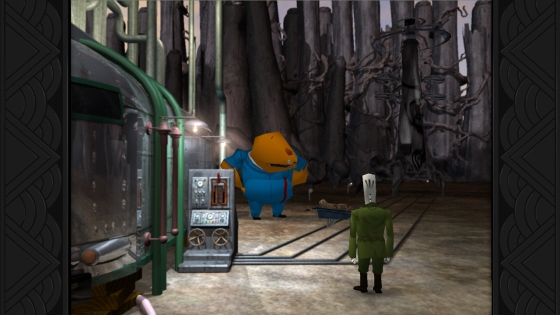 |
I might be biased in this area, since as this is one of my favorite games of all time, I have memorized every one of Grim Fandango’s puzzles to the point where I was able to recall every solution I needed fairly quickly.
…Actually, now that I think about it, that’s kind of a plus right there! After all, even the puzzles that have a hint of aggravation to them still end up being creative enough to remain etched in your memories for over a decade. While there is the occasional dilemma that requires an unorthodox solution (Why would I want a demon to vomit in a place where demon vomit clearly might do more harm than good?), or those that require an incredibly good memory or note-taking skills on the player’s part (such as an early warning about packing foam that only comes into play during the game’s final act), none of them end up being a bother, and the game is always tough but fair when it comes to problem-solving. The game’s entire array of puzzles runs the gamut from challenging to fun, and still carry the spirits of Schafer and LucasArts with them (how many other titles feature Robert Frost-shaped balloons as key ingredients towards a solution?).
For that matter, you know what? In an age where one the biggest criticisms in gaming today is how current mainstream games are too linear, simplified, and easy, we need more games like Grim Fandango. Games where the only way to advance is to think. To experiment. To consider all possibilities. To explore the grandiose world the game has laid out for us and be rewarded for doing so. We want to be challenged, dammit!
And on that note, I have noticed more than a few critics docking points from Grim Fandango Remastered for not including an in-game hint system. No disrespect against those other critics, but I am wondering how you plan to continue to keep playing games from this point on now that you’ve sucked your thumbs raw down to the bones.
4. It Looks and Sounds Dazzling, Even Seventeen Years Later
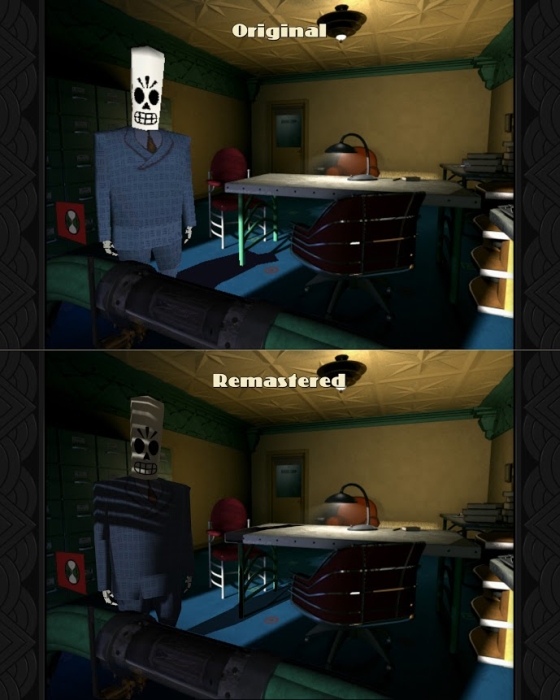 |
Surprisingly, the remastered version of Grim Fandango doesn’t change much graphics-wise…then again, it didn’t need much improvement. The game’s character models are still blocky, but in a weird way, that actually adds to the charms of the calaca-inspred character designs (the elemental characters, though, have aged…eh, less well). The new model includes a widescreen version as opposed to the standard 4:3 ratio…buuut as the game’s original pre-rendered backgrounds were never designed with wider screens in mind, all this does is stretch the screen out horizontally, and it does not look flattering. We also have a re-recorded score from The Melbourne Symphony Orchestra, so the game’s eclectic mix of jazzy tunes ranging from big band to Latin guitar still sound extremely pleasant to the ears.
One notable update to the graphics, though, is the inclusion of updated character textures and lighting. Now, keep in mind that I am a person who could usually care very little about the more technical aspects of visuals such as those, since in my personal grand scheme of things, the gameplay is ultimately what matters. But with the game having the ability to switch between the old and new graphics at the push of a button, I tried it out and holy crap, did things look better in comparison! The improvement just makes all of the characters look sleeker and blend in with the surroundings even better, and actually provides a great example of how little touches like these can play their part in the aforementioned grand scheme of things.
But in the end, it’s the art style that still acts in Grim Fandango’s trump card in this area. The game’s signature blend of art deco, Dia de los Muertos imagery, tricked-out hot rods (thanks, Glottis!), and fantasy visuals, among other things, still remains as one one of gaming’s number-one stunners when it comes to visuals simply based on the fact that there’s almost nothing else like it, even today. It all blends together to create some truly amazing imagery that’s just a joy to look at, which brings me to my next point…
3. It Has One of the Most Unique Worlds in Video Games
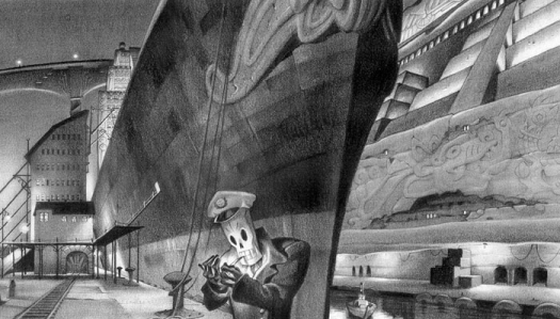 |
…Of course, those striking visuals would mean nothing if the world they decorated wasn’t an absolute blast to play in. The Land of the Dead may not be a gigantic open-world experience, but it somehow has a lot more personality to it, one with a lot of fascinating little bits of lore behind it at every corner. See, as some of the game’s characters point out, there are some souls who would prefer to dabble in more simple, earthy delights as opposed to eternal rest.
So the result is a ’40s-styled society built around a land of the supernatural, which results in a land of several fun quirks. Places where giant neon cats are ridden on racetracks and gambled upon, where flaming demon beavers inhabit petrified forests, where the weapon of choice is a gun that shoots darts which causes a person’s bones (which would be the whole body in this case) to sprout flowers and wither away, where the gate to eternal rest can contain a frigging rocket sled…you get the idea. All inhabited by folks straight out of a Bogart film with an air of intrigue to them.
As mentioned earlier, it’s all just an absolute blast to explore, to examine everything that stands out or talk to everyone around and learn how this offbeat noir-shaped neck of the woods operates. Hell, name any other game where you can waltz into a beatnik bar and perform beat poetry on open mic night (“CAN YOU HEAR ME SAYING NOTHING???”) just for the heck of it. Come to think of it, Rubacava alone is a city in the game that deserves acclaim all on its own (seriously, savor Year 2 as much as possible), but it is still just one part of a phenomenal in-game universe that still remains one of the most imaginative gaming has ever produced.
2. The Cast of Characters Remains Memorable
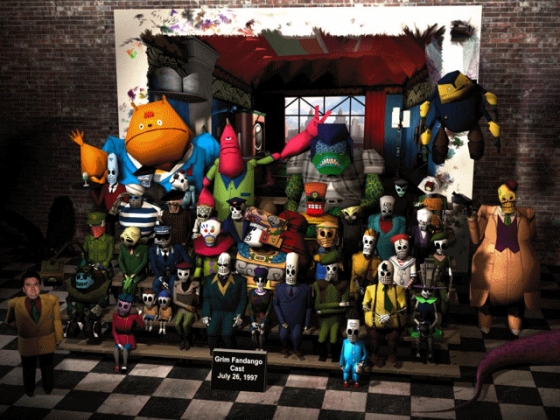 |
I fail to see how any game that features a gigantic, crazed literal speed demon driving a snarky reaper on stilts trying to close a sale by harvesting the soul of a temperamental midget can disappoint me in any way. What I’m trying to say there is that the colorful cast of characters (quite literally in a few places) that inhabit the world of Grim Fandango are a vital part of what makes it work.
Throughout your journey, you will encounter counterfeiters with Peter Lorre accents, hyperactive coat check girls enthusiastic about their jobs, and the undead equivalent of Janine from Ghostbusters, among other folks, and every one of them is a treat to chat with. Of course, it also helps that the voice acting is still top-notch, with Tony Plana leading the pack as the voice of Manny Calavera, delivering every line perfectly with just the right amount of aforementioned snarkiness befitting the type of characters in a hard-boiled pulp tale like this. He and everyone else brings their A-game, creating some of the most memorable performances and lines that have secured GF’s legacy in the video game culture lexicon still to this day. Of course, speaking of those lines…
1. The Story Is Still One of Gaming’s Finest
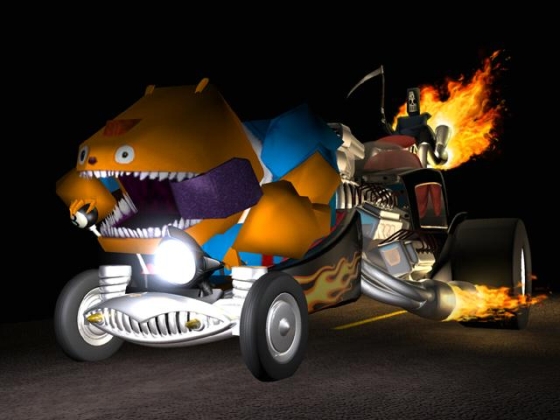 |
Looking back on things, if there was any way that Grim Fandango made an initial impact on me when it first came out, it would be that it helped me (and several others) learn that when it comes to video games, story really can matter.
I know I’m possibly wrong when it comes to this overall, but in my own memories, Grim Fandango was one of the first games to make a terrific story the top selling point. Sure, there were obviously several games with great stories before it, but story wasn’t the main selling point. Other games back in the day may have boasted FMV and CGI cinematics, to name examples, but that was advertising the way they were telling the story more than anything. Grim Fandango, however, boasted it right on the box that it was all about telling an epic tale, first and foremost.
The story of Manny’s journey to track down Meche, help untangle the web of corruption in the Department of Death, and set things right is a rock solid noir masterpiece from beginning to end with just the right amount of twists and turns. The game takes place over four years, following Manny’s developments on the Day of the Dead each year. The game uses these time skips to great effect, and introduction to new characters Manny has known for a while and new goings-on in his life is done through natural dialogue and examinations, never feels forced, and you really feel like Manny has known all of these people for a long time. As an example of this, without wishing to spoil anything, there’s a part later in which a friend of Manny’s that the player has known for all of a minute or two and gets about five lines of dialogue ends up dying (well, deader than dead) almost immediately afterwards.
In any other story, a bit like that would be considered a cheap way to wring sympathy out of the audience. But the way Grim Fandango tells and presents it, you honestly feel for Manny and his loss, no questions asked (and cheer when their killer ends up receiving a just punishment). Manny’s journey to the edge of the world and back (literally) creates some really subtle yet impressive character development, also showcased in one terrific bit in the final act. The dialogue is also superb, although that should be no surprise by this point. Even the most minor actions with a character yield some funny and witty lines, and hell, all of the game’s Achievements/Trophies are dedicated to tracking down these bits of dialogue, which should show how important they were to the developers and gamers in general over the years.
And let’s face it: In an age where triple-A games try their hardest to create overly-serious and complex narratives with moral choices, where even the best games can have the most asinine plots (hi, Batman: Arkham City!), and gamers everywhere will nitpick narratives of any major game to death (the recent debates I hear over Dragon Age: Inquisition and whether its plot is truly deep or not come to mind), it’s just a joy to once again simply play game with a perfectly-constructed, incredibly imaginative story from beginning to end, simple as that.
Then again, Grim Fandango is basically one of the main reasons all of those narratives exist. The game’s story, combined with the amazing, unique world it takes place in, is why this game is constantly mentioned as one of the pioneering (and best) examples of video games as art. It was an originator, truly something special when it first came out, and it’s still special today. Grim Fandango Remastered may not contain any huge additions to the classic (I was honestly hoping for the deleted content seen in the design document and the unlockable concept art to be included, but that was probably asking for too much), but again, it didn’t need anything huge to be added. Perfect for both new and old audiences, I am tremendously happy for one of the best games ever to be back here again for everyone to discover or rediscover.
…Now bring on Day of the Tentacle: Special Edition!!
Previously by Kyle LeClair:
TR’s 10 Best Video Games of 2014 (With Honorable Mentions)
The 17 World Premiere Trailers From The Game Awards 2014
5 Superheroic Things About inFamous: Second Son (and 5 Super-Failures)
5 Things That Make South Park: The Stick of Truth Awesome (and 2 That Make It Lame)
